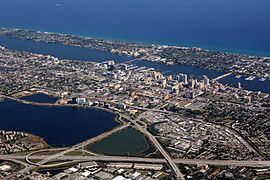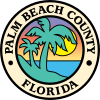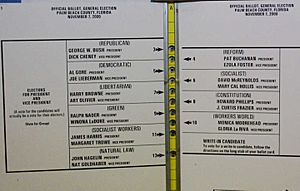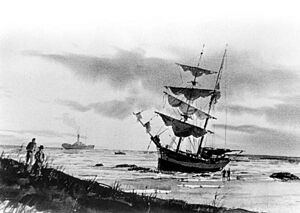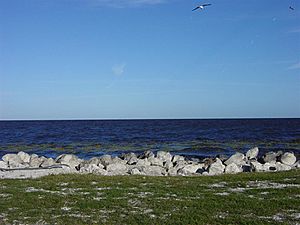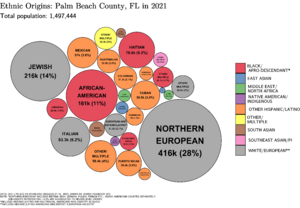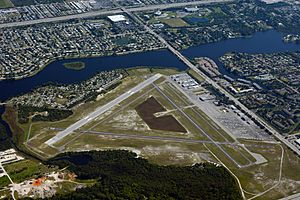Palm Beach County, Florida facts for kids
Quick facts for kids
Palm Beach County
|
|||
|---|---|---|---|
|
|||
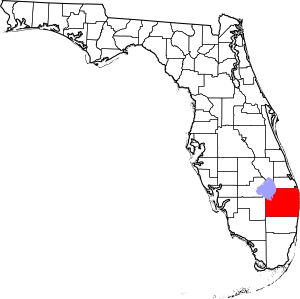 |
|||
| Founded | April 30, 1909 | ||
| County seat | West Palm Beach | ||
| Largest city | West Palm Beach | ||
| Area | |||
| • Total | 6,170 km2 (2,383 sq mi) | ||
| • Land | 5,100 km2 (1,970 sq mi) | ||
| • Water | 1,070 km2 (413 sq mi) | ||
| Population
(2020)
|
|||
| • Total | 1,492,191 | ||
| • Estimate
(2022)
|
1,513,301 | ||
| • Rank | 26th in the United States 3rd in Florida |
||
| • Density | 296.61/km2 (768.17/sq mi) | ||
| GDP | |||
| • Total | $117.543 billion (2022) | ||
| Time zone | UTC−5 (Eastern Time Zone) | ||
| • Summer (DST) | UTC−4 (Eastern Daylight Time) | ||
| Website | www.co.palm-beach.fl.us | ||
Palm Beach County is a county in southeastern Florida. It is part of the larger Miami metropolitan area. It is the third most populated county in Florida. Only Miami-Dade County and Broward County have more residents. In 2020, about 1.5 million people lived here.
The county's main city and largest city is West Palm Beach. It had over 117,000 residents in 2020. Palm Beach County was created in 1909 from part of Miami-Dade County. Its current borders were set in 1963.
Palm Beach County is one of three counties that form the Miami metropolitan area. This area was home to over 6 million people in 2020. The population has grown a lot since the late 1800s. This growth happened after Henry Flagler extended the Florida East Coast Railway. He also built famous hotels like the Royal Poinciana Hotel and The Breakers.
In 1928, a strong hurricane hit Palm Beach County. It caused a lot of damage and sadly, many people died. More recently, the county was in the news during the 2000 presidential election. A controversial vote recount happened here.
In 2004, Palm Beach County was the richest county in Florida. Its average income per person was $44,518. Farming is the county's second biggest industry, after real estate. The central and western parts of the county grow many tropical crops. These include plants for nurseries, vegetables, and sugar cane. Palm Beach County is sometimes called the "Winter Vegetable Capital" of the nation.
Contents
History of Palm Beach County

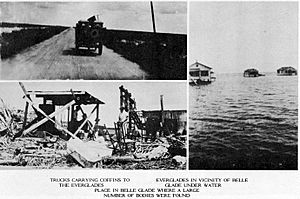
Native Americans first came to Florida about 12,000 years ago. Around 20,000 Native Americans lived in South Florida when the Spanish arrived. Their numbers dropped a lot by the 1700s. This was due to conflicts and new diseases from Europe. In 1513, Juan Ponce de León was the first European to visit this area. He landed at the Jupiter Inlet.
Some of the first non-Native American residents were African Americans. Many were once enslaved or were their children. They came to what was then Spanish Florida in the late 1600s. They found safety with the Seminole people. These African Americans fought alongside the Seminoles against white settlers. Parts of the Second Seminole War happened in Palm Beach County in 1838. This included the Battles of the Loxahatchee.
Early Buildings and Development
The oldest building still standing in the county is the Jupiter Lighthouse. It was built in 1860. President Franklin Pierce approved the land for it in 1854. During the American Civil War, Florida joined the Confederate States of America. Two Confederate supporters took out the lighthouse's light. One of them, Augustus O. Lang, was the first white settler in Palm Beach County. He built a small hut by Lake Worth in 1863. The Jupiter Lighthouse was relit in 1866 after the war.
In 1873, a hurricane caused a shipwreck. The crew survived but almost starved. Because of this, five Houses of Refuge were built along Florida's east coast. Orange Grove House of Refuge No. 3 was built near Delray Beach in 1876.
Henry Flagler's Influence
Few people lived in Palm Beach County before Henry Flagler arrived in the early 1890s. Flagler was a very rich businessman from Standard Oil. He was key to the county's growth around 1900. He bought land on both sides of Lake Worth. Other investors followed, causing a small building boom. This led to many new businesses.
The Royal Poinciana Hotel, built by Flagler, opened in February 1894. It was for rich tourists. About a month later, Flagler's Florida East Coast Railway reached West Palm Beach. On November 5, 1894, West Palm Beach became the county's oldest city. In 1896, Flagler opened another hotel, The Palm Beach Inn, later called The Breakers. He also built his own winter home in 1902. Other important people like Major Nathan Boynton and Congressman William S. Linton also helped develop communities. These later became Boynton Beach, Delray Beach, and Boca Raton.
County Boundaries and Growth
The Florida Legislature created Palm Beach County in 1909. It was carved out of the northern part of Dade County. It first included all of Lake Okeechobee. Later, parts of Palm Beach County were used to create other counties. Broward County was formed in 1915. Okeechobee County was formed in 1917. Martin County was formed in 1925.
The county's borders stayed the same until 1963. Then, Florida reduced Palm Beach County's share of Lake Okeechobee. A small piece of land was given to Broward County in 2009.
The 1910s and 1920s brought a lot of growth to South Florida. This was during the Florida land boom of the 1920s. Many historic buildings in Palm Beach County were built in the 1920s. Architects like Addison Mizner were very important. Property values in West Palm Beach grew from $13.6 million in 1920 to $89 million in 1929. The city's population quadrupled between 1920 and 1927.
Major Storms and Recovery
On September 17, 1928, the 1928 Okeechobee hurricane hit near West Palm Beach. It was a very strong storm. It caused huge damage in the eastern part of the county. The area around Lake Okeechobee suffered even more. Strong winds pushed lake water over hundreds of square miles. This flooded communities like Belle Glade and Pahokee. At least 2,500 people died, many of them migrant farmers.
The hurricane destroyed 552 businesses and damaged 1,447 others. It also destroyed 3,584 homes and damaged 11,409. This left 4,008 families without homes. The total damage in South Florida was about $25 million. After the storm, the Herbert Hoover Dike was built. This was to prevent similar disasters.
The 1926 and 1928 hurricanes caused economic problems. They pushed the region into the Great Depression early. Housing prices in the county dropped a lot. However, the 1930s also brought an airport. Morrison Field, now Palm Beach International Airport, opened in 1936.
During World War II, the airport became an Air Force Base. Thousands of servicemen came to Palm Beach County for training. After the war, many veterans returned to the area. They came for work, vacations, or retirement. People continued to move to the county into the 21st century.
On August 28, 1949, another strong hurricane hit Lake Worth Beach. It caused a lot of damage. It destroyed 65 homes and damaged 13,283 others in the county.
Modern Era and Key Events
The area's first TV station, WIRK-TV, started broadcasting in 1953. Other stations like WPTV-TV and WPEC began in 1954 and 1955. They are still on air today.
In December 1960, there was a plot to harm President-elect John F. Kennedy in Palm Beach. The plot was stopped when Kennedy was with his family. A secret blast shelter was built on Peanut Island during his presidency. This was due to rising Cold War tensions.
Hurricane David hit near West Palm Beach on September 3, 1979. Its strong winds broke windows and damaged property. Many buildings were flooded from heavy rain. The storm caused $30 million in damage, mostly to farms.
The county became famous during the 2000 United States presidential election. A special ballot, called the "butterfly ballot," caused confusion. Many people thought it led to votes for the wrong candidate. Because the statewide results were very close, a recount was ordered. However, the Supreme Court of the United States stopped the recount. This led to George W. Bush winning the election.
After the September 11 attacks in 2001, an investigation found that some hijackers had trained or lived in Palm Beach County. Later that month, during the anthrax attacks, a dangerous substance was mailed to a building in Boca Raton. One person died after being exposed.
Three hurricanes hit Palm Beach County hard in 2004 and 2005. Hurricane Frances (2004) damaged about 15,000 houses and 2,400 businesses. Six people died. Hurricane Jeanne (2004) also caused strong winds and damaged homes. It left about $260 million in damage. Hurricane Wilma (2005) crossed Palm Beach County directly. Over 90% of homes lost power. The storm damaged over 55,000 homes and 3,600 businesses. Palm Beach County suffered about $2.9 billion in damages.
In August 2012, Hurricane Isaac brought heavy rain. This caused flooding in areas like The Acreage and Loxahatchee. Some neighborhoods were cut off for days. In September 2017, Hurricane Irma caused evacuations for over 290,000 residents. The storm caused widespread power outages and damaged trees. It left about $300 million in damage and five people died.
Why is it called Palm Beach County?
The coconut palm tree is not native to Florida. It came to what is now Palm Beach County because of a shipwreck. In 1878, a Spanish ship called Providencia wrecked near today's Mar-a-Lago. It was carrying coconuts from Havana to Cádiz, Spain. The coconuts were saved and thousands were planted. Soon, a thick grove of palm trees grew. This area was later named Palm Beach.
Geography of Palm Beach County
| Weather chart for Palm Beach, FL | |||||||||||||||||||||||||||||||||||||||||||||||
|---|---|---|---|---|---|---|---|---|---|---|---|---|---|---|---|---|---|---|---|---|---|---|---|---|---|---|---|---|---|---|---|---|---|---|---|---|---|---|---|---|---|---|---|---|---|---|---|
| J | F | M | A | M | J | J | A | S | O | N | D | ||||||||||||||||||||||||||||||||||||
|
2.4
75
56
|
2.4
77
57
|
3.8
79
59
|
2.5
83
62
|
4
88
67
|
8
90
72
|
6.7
91
73
|
7.4
91
73
|
7.4
90
72
|
4.3
86
69
|
3.2
81
62
|
2.2
76
57
|
||||||||||||||||||||||||||||||||||||
| temperatures in °F precipitation totals in inches |
|||||||||||||||||||||||||||||||||||||||||||||||
|
Metric conversion
|
|||||||||||||||||||||||||||||||||||||||||||||||
Palm Beach County covers about 2,383 square miles. About 1,970 square miles are land, and 413 square miles are water. This makes it the second largest county in Florida by land area. Much of the water is the Atlantic Ocean and Lake Okeechobee. The county has about 526,000 acres of farmland.
The eastern part of Palm Beach County is very developed with cities. The central and western parts are more suburban or rural. Palm Beach County is one of three counties in the Miami metropolitan area. However, its western communities near Lake Okeechobee are also seen as part of the rural Florida Heartland.
The Atlantic coastline of Palm Beach County is about 47 miles long. It has many barrier islands and peninsulas. These include Jupiter Island, Singer Island, and Palm Beach Island. These islands are separated from the mainland by the Intracoastal Waterway. This waterway is often called the Lake Worth Lagoon.
The main landmasses are split by four inlets:
- Jupiter Inlet
- Lake Worth Inlet
- South Lake Worth Inlet
- Boca Raton Inlet
Two of these inlets, Jupiter and Boca Raton, are natural but have been changed a lot. The Lake Worth and South Lake Worth inlets were made by people. There are also other islands in the Intracoastal Waterway. These include Hypoluxo Island, Munyon Island, and Peanut Island.
Neighboring Counties
Palm Beach County shares borders with:
- Martin County – to the north
- Broward County – to the south
- Hendry County – to the west
- Glades County – to the northwest
- Okeechobee County – to the northwest, in the middle of Lake Okeechobee
Natural Areas and Preserves
Palm Beach County has many beautiful natural areas:
- Arthur R. Marshall Loxahatchee National Wildlife Refuge in Boynton Beach (147,392 acres)
- DuPuis Management Area (21,875 acres)
- John D. MacArthur Beach State Park in North Palm Beach (348 acres)
- J.W. Corbett Wildlife Management Area (60,348 acres)
- Jupiter Ridge Natural Area in Jupiter (271 acres)
- Juno Dunes Natural Area in Juno Beach (576 acres)
- Frenchman's Forest Natural Area in Palm Beach Gardens (158 acres)
- Sweetbay Natural Area in Palm Beach Gardens (1,094 acres)
- Royal Palm Beach Pines Natural Area in Royal Palm Beach (773 acres)
- Hypoluxo Scrub Natural Area in Hypoluxo (97 acres)
- Rosemary Scrub Natural Area in Boynton Beach (14 acres)
- Seacrest Scrub Natural Area in Boynton Beach (54 acres)
- Delray Oaks Natural Area in Delray Beach (25 acres)
- Leon M. Weekes Environmental Preserve in Delray Beach (12 acres)
- Grassy Waters Everglades Preserve in West Palm Beach (14,720 acres)
The county also has many coral reef patches along its coast. Efforts are made to protect these important reefs.
People and Population
| Historical population | |||
|---|---|---|---|
| Census | Pop. | %± | |
| 1910 | 5,577 | — | |
| 1920 | 18,654 | 234.5% | |
| 1930 | 51,781 | 177.6% | |
| 1940 | 79,989 | 54.5% | |
| 1950 | 114,688 | 43.4% | |
| 1960 | 228,106 | 98.9% | |
| 1970 | 348,993 | 53.0% | |
| 1980 | 576,863 | 65.3% | |
| 1990 | 863,518 | 49.7% | |
| 2000 | 1,131,184 | 31.0% | |
| 2010 | 1,320,134 | 16.7% | |
| 2020 | 1,492,191 | 13.0% | |
| 2023 (est.) | 1,533,801 | 16.2% | |
| U.S. Decennial Census 1910–1970 1980 1990 2000 2010 2020 2022 |
|||
Palm Beach County has grown a lot over the years. In 1910, there were about 5,500 people. By 2020, the population was nearly 1.5 million.
Who Lives in Palm Beach County?
The county is home to a diverse group of people. In 2020:
- About 52% of residents were White (not Hispanic).
- About 23.5% were Hispanic or Latino.
- About 17% were Black or African American.
- About 2.9% were Asian American.
The median age in Palm Beach County in 2020 was 45.3 years old. This means half the people were older and half were younger than 45.3.
Languages Spoken at Home
Most people in Palm Beach County speak English at home. However, many other languages are also spoken. In 2015:
- 68.9% spoke English.
- 18.4% spoke Spanish or Spanish Creole.
- 6.3% spoke French or Haitian Creole.
- 6.4% spoke other languages.
Where Do People Come From?
Many people living in Palm Beach County were born in the United States. However, a growing number of residents were born in other countries. In 2015, about 24.6% of the population was born outside the U.S. Many foreign-born residents come from:
- Haiti
- Cuba
- Jamaica
- Mexico
- Colombia
Economy and Jobs
Companies with their main offices in Palm Beach County include:
- Office Depot
- The ADT Corporation
- TBC Corporation
- NextEra Energy
- The GEO Group
- American Sugar Refining
- Carrier
The county also has many aerospace companies. These include United Technologies and Pratt & Whitney Rocketdyne. These companies are big employers in the area. The largest employer in Palm Beach County is the School District of Palm Beach County. It has over 27,000 employees, including many teachers.
In 2010, the average income for a household in the county was $53,242. For a family, it was $64,445. About 12.2% of the population lived below the poverty line.
Fun Things to Do in Palm Beach County
Sports and Teams
Palm Beach County is a great place for sports fans!
- The St. Louis Cardinals and Miami Marlins baseball teams do their spring training here. They play at Roger Dean Stadium in Jupiter.
- Two minor league baseball teams, the Jupiter Hammerheads and Palm Beach Cardinals, also play at Roger Dean Stadium.
- The Ballpark of the Palm Beaches in West Palm Beach hosts the Washington Nationals and Houston Astros for spring training.
- The Florida Atlantic Owls are a college sports team. Their football team plays at FAU Stadium. Their basketball team plays at FAU Arena.
- USL Palm Beach is a new professional soccer team starting in 2023.
Popular Tourist Spots
There are many fun places to visit and annual events in Palm Beach County:
- South Florida Fair
- SunFest (a music and art festival)
- Boat Show
- Winter Equestrian Festival (for horse lovers)
- Lion Country Safari (drive-through safari park)
- Rapids Water Park (water slides and pools)
- Kravis Center for the Performing Arts (for shows and concerts)
- South Florida Science Museum
- Palm Beach Zoo at Dreher Park
- Flagler Museum (Henry Flagler's former home)
- Jupiter Inlet Lighthouse
- Worth Avenue (famous shopping street)
- Peanut Island
- Mounts Botanical Garden
- Morikami Museum and Japanese Gardens
The county also has many shopping malls. These include the Palm Beach Outlets and The Gardens Mall.
Local Media
You can find out what's happening in Palm Beach County through local media:
- The Palm Beach Post (newspaper)
- Palm Beach Daily News (newspaper)
- Sun-Sentinel (newspaper)
- WPTV-TV (TV station)
- WPBF-TV (TV station)
- WFLX (TV station)
- WPEC (TV station)
Getting Around Palm Beach County
Roads and Highways
Some roads in Palm Beach County have been criticized for not being safe for walkers and bikers. Local cities are trying to make them safer.
Major Roads
 Interstate 95
Interstate 95 Florida's Turnpike
Florida's Turnpike- US 441 / SR 7
- Military Trail (SR 809)
- Congress Avenue (SR 807)
- US 1 / Federal Highway
- Ocean Boulevard (SR A1A)
- US 98 / SR 80 / Southern Boulevard
- Bee Line Highway (SR 710)
Trains and Airports
Palm Beach County has several train options:
- Tri-Rail runs along the eastern part of the county. It has stops in Boca Raton, Delray Beach, Boynton Beach, Lake Worth Beach, West Palm Beach, and Mangonia Park.
- Amtrak offers long-distance train service. You can catch the Silver Meteor and Silver Star in West Palm Beach and Delray Beach.
- Brightline connects West Palm Beach and Boca Raton to Orlando in the north. It also connects to Fort Lauderdale and Miami in the south.
The county has several airports:
- Palm Beach International Airport (PBI)
- Palm Beach County Park Airport
- North Palm Beach County General Aviation Airport
- Boca Raton Airport
- Palm Beach County Glades Airport
Public Transportation
- PalmTran provides bus service throughout Palm Beach County.
Seaport
The Port of Palm Beach is in Riviera Beach. You can take 2-day cruises to the Bahamas from here.
Trails
The Lake Okeechobee Scenic Trail passes through the county. It is part of the Florida National Scenic Trail.
Education in Palm Beach County
Schools for Kids and Teens
All schools in Palm Beach County are part of the School District of Palm Beach County. In 2006, it was the fourth largest school district in Florida. It was also the 11th largest in the United States. The district had 164 schools, including 25 high schools. There were also 33 charter schools.
Some Palm Beach County high schools have been recognized as top schools. These include Atlantic Community High School, Suncoast High School, and the Alexander Dreyfoos School of the Arts. These are all public magnet schools.
There are also many private schools in the county. Some examples are American Heritage School and The Benjamin School.
Colleges and Universities
Palm Beach County has several colleges and universities for higher education:
- Florida Atlantic University
- Florida International University
- Lynn University
- Nova Southeastern University
- Palm Beach Atlantic University
- Palm Beach State College
- Keiser University
Public Libraries
Palm Beach County has a public library system called the Palm Beach County Library System. It started in 1967. It has 17 library branches and a bookmobile. The bookmobile visits over 40 stops each month. A new branch is being built in western Boynton Beach. It is expected to open in 2024.
The main library is in an unincorporated part of West Palm Beach. It is the largest library service in the county. It has over 1.88 million items.
Many cities in the county also have their own libraries. These city libraries work together with the county system. This allows people to use resources from both.
The county's first library started in 1895 in West Palm Beach. It was a Free Reading Room in a church. In 1899, the West Palm Beach Public Library officially began. It was in a building donated by Commodore Charles John Clarke. Henry Flagler also donated $100. A permanent building was built in 1924. The library moved to a new, larger building in 2012. It was renamed the Mandel Public Library of West Palm Beach after a large donation.
Communities in Palm Beach County
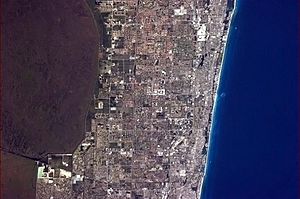
The largest city and county seat is West Palm Beach. In 2020, it had 117,415 people. Boca Raton is the second largest city. It is in the southernmost part of the county, next to Broward County. It had 97,422 people in 2020. Boynton Beach is the third largest city. It is between Boca Raton and West Palm Beach. Its population was about 80,380 in 2020.
Palm Beach County has 39 cities, towns, and villages. The newest city is Westlake, created in 2016.
| # | Incorporated community | Designation | Date incorporated | Population (2020) |
|---|---|---|---|---|
| 1 | Pahokee | City | 1922 | 5,524 |
| 2 | Belle Glade | City | April 9, 1928 | 16,698 |
| 3 | South Bay | City | 1941 | 4,860 |
| 4 | Tequesta | Village | 1957 | 6,158 |
| 5 | Jupiter Inlet Colony | Town | 1959 | 405 |
| 6 | Jupiter | Town | February 9, 1925 | 61,047 |
| 7 | Juno Beach | Town | June 4, 1953 | 3,858 |
| 8 | Palm Beach Gardens | City | June 20, 1959 | 59,182 |
| 9 | North Palm Beach | Village | August 13, 1956 | 13,162 |
| 10 | Lake Park | Town | 1923 | 9,047 |
| 11 | Riviera Beach | City | September 29, 1922 | 37,604 |
| 12 | Palm Beach Shores | Town | 1951 | 1,330 |
| 13 | Mangonia Park | Town | 1947 | 2,142 |
| 14 | Palm Beach | Town | April 17, 1911 | 9,245 |
| 15 | West Palm Beach | City | November 5, 1894 | 117,415 |
| 16 | Haverhill | Town | 1950 | 2,187 |
| 17 | Glen Ridge | Town | 1948 | 217 |
| 18 | Cloud Lake | Town | 1947 | 134 |
| 19 | Palm Springs | Village | July 4, 1957 | 26,890 |
| 20 | Lake Clarke Shores | Town | 1957 | 3,564 |
| 21 | Royal Palm Beach | Village | June 18, 1959 | 38,932 |
| 22 | Wellington | Village | December 31, 1995 | 61,637 |
| 23 | Greenacres | City | May 24, 1926 | 43,990 |
| 24 | Atlantis | City | 1959 | 2,142 |
| 25 | Lake Worth Beach | City | June 14, 1913 | 42,219 |
| 26 | South Palm Beach | Town | 1955 | 1,471 |
| 27 | Lantana | Town | July 20, 1921 | 11,504 |
| 28 | Manalapan | Town | 1931 | 419 |
| 29 | Hypoluxo | Town | 1955 | 2,687 |
| 30 | Boynton Beach | City | 1920 | 80,380 |
| 31 | Ocean Ridge | Town | 1931 | 1,830 |
| 32 | Golf | Village | 1957 | 255 |
| 33 | Briny Breezes | Town | March 19, 1963 | 502 |
| 34 | Gulf Stream | Town | 1925 | 954 |
| 35 | Delray Beach | City | October 9, 1911 | 66,846 |
| 36 | Highland Beach | Town | 1949 | 4,295 |
| 37 | Boca Raton | City | May 26, 1925 | 97,422 |
| 38 | Loxahatchee Groves | Town | November 1, 2006 | 3,355 |
| 39 | Westlake | City | 2016 | 906 |
Other Communities
Some areas are not officially cities or towns but are recognized for census purposes. These are called census-designated places (CDPs).
- Acacia Villas
- Cabana Colony
- Canal Point
- Gun Club Estates
- Juno Ridge
- Jupiter Farms
- Kenwood Estates
- Lake Belvedere Estates
- Lake Harbor
- Limestone Creek
- Pine Air
- Plantation Mobile Home Park
- Royal Palm Estates
- San Castle
- Schall Circle
- Seminole Manor
- Stacey Street
- The Acreage
- Watergate
- Westgate
There is also an unincorporated community called West Boca Raton.
See also
 In Spanish: Condado de Palm Beach para niños
In Spanish: Condado de Palm Beach para niños


